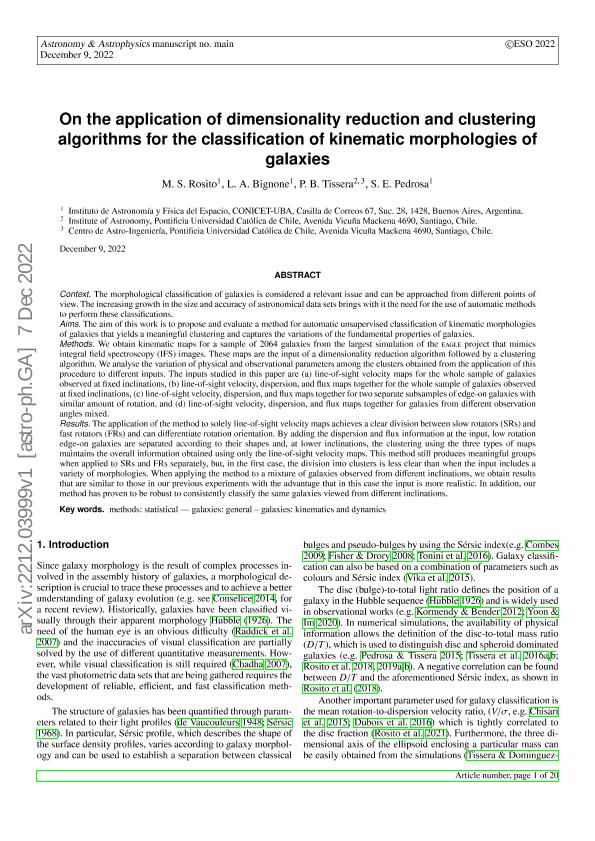Mostrar el registro sencillo del ítem
dc.contributor.author
Rosito, M. S.
dc.contributor.author
Bignone, Lucas Axel

dc.contributor.author
Tissera, P. B.
dc.contributor.author
Pedrosa, Susana Elizabeth

dc.date.available
2024-01-23T13:24:44Z
dc.date.issued
2023-03
dc.identifier.citation
Rosito, M. S.; Bignone, Lucas Axel; Tissera, P. B.; Pedrosa, Susana Elizabeth; Application of dimensionality reduction and clustering algorithms for the classification of kinematic morphologies of galaxies; EDP Sciences; Astronomy and Astrophysics; 671; 3-2023; 1-20
dc.identifier.issn
0004-6361
dc.identifier.uri
http://hdl.handle.net/11336/224575
dc.description.abstract
Context. The morphological classification of galaxies is considered a relevant issue and can be approached from different points of view. The increasing growth in the size and accuracy of astronomical data sets brings with it the need for the use of automatic methods to perform these classifications. Aims. The aim of this work is to propose and evaluate a method for the automatic unsupervised classification of kinematic morphologies of galaxies that yields a meaningful clustering and captures the variations of the fundamental properties of galaxies. Methods.We obtained kinematic maps for a sample of 2064 galaxies from the largest simulation of the EAGLE project that mimics integral field spectroscopy images. These maps are the input of a dimensionality reduction algorithm followed by a clustering algorithm. We analysed the variation of physical and observational parameters among the clusters obtained from the application of this procedure to different inputs. The inputs studied in this paper are (a) line-of-sight velocity maps for the whole sample of galaxies observed at fixed inclinations; (b) line-of-sight velocity, dispersion, and flux maps together for the whole sample of galaxies observed at fixed inclinations; (c) line-of-sight velocity, dispersion, and flux maps together for two separate subsamples of edge-on galaxies with similar amount of rotation; and (d) line-of-sight velocity, dispersion, and flux maps together for galaxies from different observation angles mixed. Results. The application of the method to solely line-of-sight velocity maps achieves a clear division between slow rotators (SRs) and fast rotators (FRs) and can differentiate rotation orientation. By adding the dispersion and flux information at the input, low-rotation edge-on galaxies are separated according to their shapes and, at lower inclinations, the clustering using the three types of maps maintains the overall information obtained using only the line-of-sight velocity maps. This method still produces meaningful groups when applied to SRs and FRs separately, but in the first case the division into clusters is less clear than when the input includes a variety of morphologies. When applying the method to a mixture of galaxies observed from different inclinations, we obtain results that are similar to those in our previous experiments with the advantage that in this case the input is more realistic. In addition, our method has proven to be robust: it consistently classifies the same galaxies viewed from different inclinations.
dc.format
application/pdf
dc.language.iso
eng
dc.publisher
EDP Sciences

dc.rights
info:eu-repo/semantics/openAccess
dc.rights.uri
https://creativecommons.org/licenses/by-nc-sa/2.5/ar/
dc.subject
GALAXIES: GENERAL
dc.subject
GALAXIES: KINEMATICS AND DYNAMICS
dc.subject
METHODS: STATISTICAL
dc.subject.classification
Astronomía

dc.subject.classification
Ciencias Físicas

dc.subject.classification
CIENCIAS NATURALES Y EXACTAS

dc.title
Application of dimensionality reduction and clustering algorithms for the classification of kinematic morphologies of galaxies
dc.type
info:eu-repo/semantics/article
dc.type
info:ar-repo/semantics/artículo
dc.type
info:eu-repo/semantics/publishedVersion
dc.date.updated
2024-01-23T11:48:18Z
dc.journal.volume
671
dc.journal.pagination
1-20
dc.journal.pais
Francia

dc.description.fil
Fil: Rosito, M. S.. Consejo Nacional de Investigaciones Científicas y Técnicas. Oficina de Coordinación Administrativa Ciudad Universitaria. Instituto de Astronomía y Física del Espacio. - Universidad de Buenos Aires. Facultad de Ciencias Exactas y Naturales. Instituto de Astronomía y Física del Espacio; Argentina
dc.description.fil
Fil: Bignone, Lucas Axel. Consejo Nacional de Investigaciones Científicas y Técnicas. Oficina de Coordinación Administrativa Ciudad Universitaria. Instituto de Astronomía y Física del Espacio. - Universidad de Buenos Aires. Facultad de Ciencias Exactas y Naturales. Instituto de Astronomía y Física del Espacio; Argentina
dc.description.fil
Fil: Tissera, P. B.. Universidad Católica de Chile; Chile. Pontificia Universidad Católica de Chile; Chile
dc.description.fil
Fil: Pedrosa, Susana Elizabeth. Consejo Nacional de Investigaciones Científicas y Técnicas. Oficina de Coordinación Administrativa Ciudad Universitaria. Instituto de Astronomía y Física del Espacio. - Universidad de Buenos Aires. Facultad de Ciencias Exactas y Naturales. Instituto de Astronomía y Física del Espacio; Argentina
dc.journal.title
Astronomy and Astrophysics

dc.relation.alternativeid
info:eu-repo/semantics/altIdentifier/doi/http://dx.doi.org/10.1051/0004-6361/202244707
Archivos asociados
